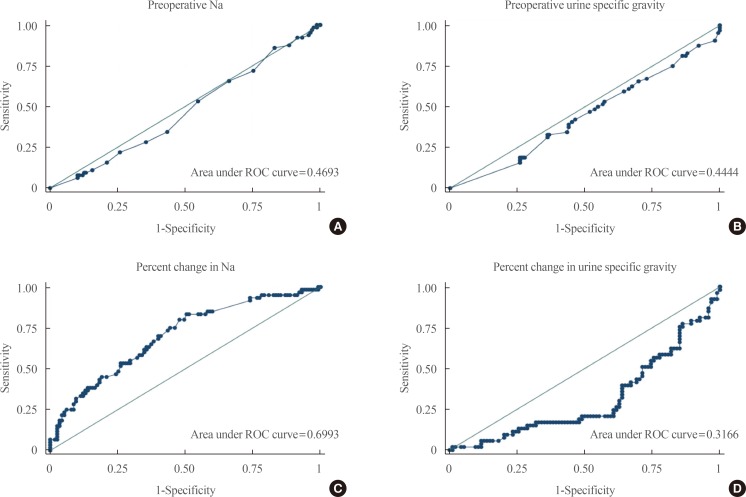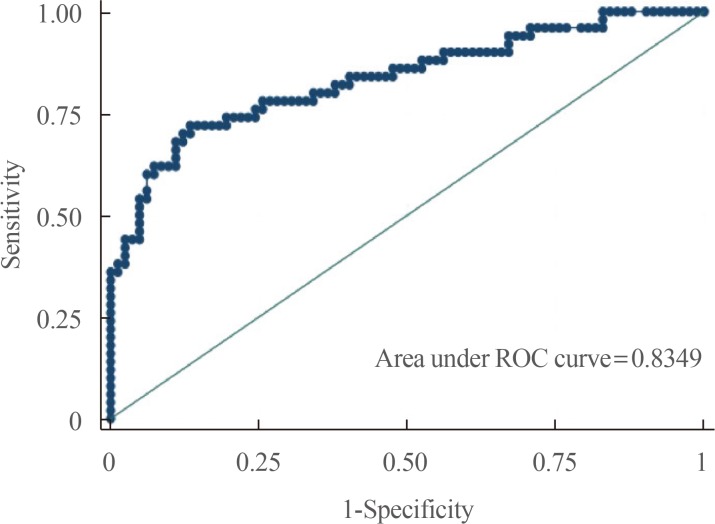Endocrinol Metab.
2017 Dec;32(4):426-433. 10.3803/EnM.2017.32.4.426.
Factors Associated with Postoperative Diabetes Insipidus after Pituitary Surgery
- Affiliations
-
- 1Section of Endocrinology, Diabetes and Metabolism, Department of Medicine, Philippine General Hospital, University of the Philippines, Manila, Philippines. aj_tons@yahoo.com
- KMID: 2406186
- DOI: http://doi.org/10.3803/EnM.2017.32.4.426
Abstract
- BACKGROUND
Determining risk factors for diabetes insipidus (DI) after pituitary surgery is important in improving patient care. Our objective is to determine the factors associated with DI after pituitary surgery.
METHODS
We reviewed records of patients who underwent pituitary surgery from 2011 to 2015 at Philippine General Hospital. Patients with preoperative DI were excluded. Multiple logistic regression analysis was performed and a predictive model was generated. The discrimination abilities of the predictive model and individual variables were assessed using the receiving operator characteristic curve.
RESULTS
A total of 230 patients were included. The rate of postoperative DI was 27.8%. Percent change in serum Na (odds ratio [OR], 1.39; 95% confidence interval [CI], 1.15 to 1.69); preoperative serum Na (OR, 1.19; 95% CI, 1.02 to 1.40); and performance of craniotomy (OR, 5.48; 95% CI, 1.60 to 18.80) remained significantly associated with an increased incidence of postoperative DI, while percent change in urine specific gravity (USG) (OR, 0.53; 95% CI, 0.33 to 0.87) and meningioma on histopathology (OR, 0.05; 95% CI, 0.04 to 0.70) were significantly associated with a decreased incidence. The predictive model generated has good diagnostic accuracy in predicting postoperative DI with an area under curve of 0.83.
CONCLUSION
Greater percent change in serum Na, preoperative serum Na, and performance of craniotomy significantly increased the likelihood of postoperative DI while percent change in USG and meningioma on histopathology were significantly associated with a decreased incidence. The predictive model can be used to generate a scoring system in estimating the risk of postoperative DI.
Keyword
MeSH Terms
Figure
Reference
-
1. Zimmerman EA, Robinson AG. Hypothalamic neurons secreting vasopressin and neurophysin. Kidney Int. 1976; 10:12–24. PMID: 59834.
Article2. Singer PA, Sevilla LJ. Postoperative endocrine management of pituitary tumors. Neurosurg Clin N Am. 2003; 14:123–138. PMID: 12690984.
Article3. Sheehan JM, Sheehan JP, Douds GL, Page RB. DDAVP use in patients undergoing transsphenoidal surgery for pituitary adenomas. Acta Neurochir (Wien). 2006; 148:287–291. discussion 291. PMID: 16362179.
Article4. Postoperative diabetes insipidus. BMJ. 1989; 298(6671):459.5. Black PM, Zervas NT, Candia GL. Incidence and management of complications of transsphenoidal operation for pituitary adenomas. Neurosurgery. 1987; 20:920–924. PMID: 3614573.
Article6. Hensen J, Henig A, Fahlbusch R, Meyer M, Boehnert M, Buchfelder M. Prevalence, predictors and patterns of postoperative polyuria and hyponatraemia in the immediate course after transsphenoidal surgery for pituitary adenomas. Clin Endocrinol (Oxf). 1999; 50:431–439. PMID: 10468901.
Article7. Fonte JS, Cunanan EC, Matawaran BJ, Mercado-Asis LB. Treatment outcomes of pituitary tumors at the University of Santo Tomas Hospital: 2004-2008. Philipp J Intern Med. 2009; 47:121–128.
Article8. Alinsonorin DG, Santos-Batongbacal MA, Paz-Pacheco E, Trajano-Acampado L. Pituitary adenoma: clinical profile of 120 patients at the Philippine General Hospital. Philipp J Intern Med. 2003; 41:323–329.9. Nemergut EC, Zuo Z, Jane JA Jr, Laws ER Jr. Predictors of diabetes insipidus after transsphenoidal surgery: a review of 881 patients. J Neurosurg. 2005; 103:448–454. PMID: 16235676.
Article10. Schreckinger M, Walker B, Knepper J, Hornyak M, Hong D, Kim JM, et al. Post-operative diabetes insipidus after endoscopic transsphenoidal surgery. Pituitary. 2013; 16:445–451. PMID: 23242859.
Article11. Hans P, Stevenaert A, Albert A. Study of hypotonic polyuria after trans-sphenoidal pituitary adenomectomy. Intensive Care Med. 1986; 12:95–99. PMID: 3700841.
Article12. Schreckinger M, Szerlip N, Mittal S. Diabetes insipidus following resection of pituitary tumors. Clin Neurol Neurosurg. 2013; 115:121–126. PMID: 22921808.
Article
- Full Text Links
- Actions
-
Cited
- CITED
-
- Close
- Share
- Similar articles
-
- A case of Sheehan's syndrome with central diabetes insipidus showing hemorrhagic pituitary apoplexy
- Three Cases of Diabetes Insipidus
- A Case of Diabetes Insipidus in a Child with Eosinophilic Granuloma of Pituitary Stalk
- A Case of Central Diabetes Insipidus Developed during Puerperium
- A Case of Pituitary Metastasis of Breast Cancer Presenting as Diabetes Insipidus and Panhypopituitarism



